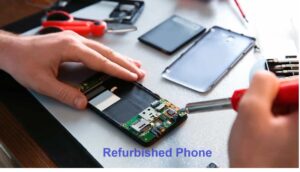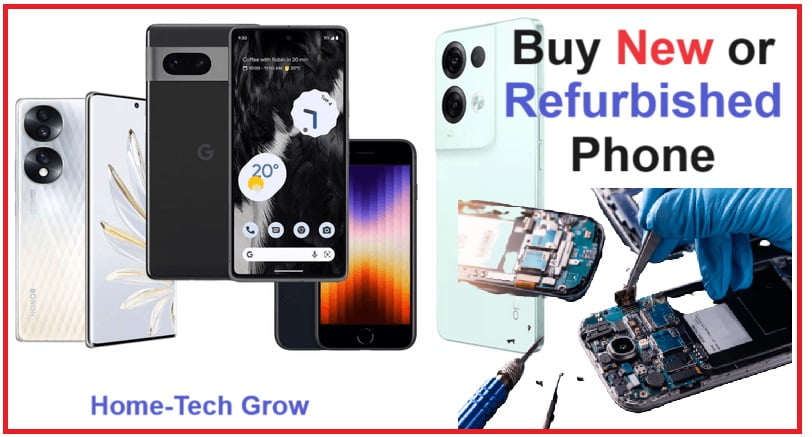Table of Contents
ToggleRefurbished Phones
- Refurbished phones can be a good choice for many reasons, but there are also some considerations to keep in mind.
- Here are the pros and cons of buying a refurbished phone:
What Components are Deplaced in Refurbished Phone
- In a refurbished phone, several components may be replaced or repaired to restore the device to good working condition.
- The specific components replaced can vary depending on the condition of the phone and the refurbisher’s standards.
- Here are some common components that are often addressed in the refurbishment process:

Commonly Replaced Components in Refurbished Phones:
- Battery:
- Batteries are often replaced if they no longer hold a charge well or if their performance is significantly degraded.
- Screen and Display:
- The screen is frequently replaced if it has cracks, scratches, dead pixels, or other display issues.
- Casing and Exterior:
- The outer casing or housing of the phone might be replaced if it is damaged, scratched, or worn.
- Buttons and Ports:
- Physical buttons (like the power button, volume buttons, or home button) and ports (such as the charging port or headphone jack) are replaced if they are not functioning correctly.
- Camera:
- The front and/or rear cameras might be replaced if they are not working properly or if they produce poor-quality images.
- Speakers and Microphone:
- These components can be replaced if they are faulty or if there are issues with sound quality during calls or media playback.
- Motherboard and Internal Chips:
- In some cases, internal components like the motherboard, processors, or other chips may be replaced or repaired if there are significant issues.
- Sensors:
- Sensors (such as the proximity sensor, accelerometer, gyroscope, or fingerprint sensor) are replaced if they are malfunctioning.
Refurbishment Process Steps:
- Initial Inspection:
- The phone is thoroughly inspected to identify any defects or issues.
- Component Replacement:
- Faulty or worn components are replaced with new or refurbished parts.
- Cleaning:
- The phone is cleaned both externally and internally to remove any dust, dirt, or debris.
- Software Update and Reset:
- The phone’s software is updated to the latest compatible version, and the device is reset to factory settings to ensure all previous data is wiped.
- Testing:
- Comprehensive testing is performed to ensure all functions and features of the phone are working correctly, including battery life, connectivity, sensors, and performance.
- Final Inspection and Packaging:
- A final inspection is done to ensure the phone meets quality standards, and the device is then packaged for sale.

Advantages Refurbished Phones
- Cost Savings: Refurbished phones are generally much cheaper than brand-new ones.
- Quality Assurance: Reputable sellers often thoroughly test and repair refurbished phones, ensuring they are in good working condition.
- Environmental Impact: Buying refurbished is an eco-friendly option as it reduces electronic waste and the demand for new resources.
- Warranty: Many refurbished phones come with a warranty, providing some security in case of issues.
- Access to Older Models: If you prefer a discontinued model, refurbished options may be the only way to find one.
Disadvantages:
- Potential for Wear and Tear: Refurbished phones may show signs of previous use, such as scratches or reduced battery life.
- Uncertainty About Quality: The quality of refurbishment can vary significantly depending on the seller. It’s essential to buy from a reputable source.
- Shorter Lifespan: Refurbished phones may not last as long as new ones, particularly if they have been heavily used before refurbishment.
- Software Updates: Older models may not receive the latest software updates, potentially missing out on new features and security patches.
- Limited Choice: The availability of specific models or configurations may be limited compared to new phones.
Tips for Buying a Refurbished Phone:
- Research the Seller: Choose a reputable retailer or manufacturer that offers a warranty and has good customer reviews.
- Check the Warranty: Ensure the phone comes with a warranty and understand the terms.
- Inspect the Phone: If possible, inspect the phone for physical damage and test its functionality before purchasing.
- Understand the Return Policy: Make sure you can return the phone if it doesn’t meet your expectations.
Overall, a refurbished phone can be a great way to save money while still getting a reliable device, as long as you buy from a trustworthy source and understand the potential risks.

Common Issues with Refurbished Phones
Post Views: 456
